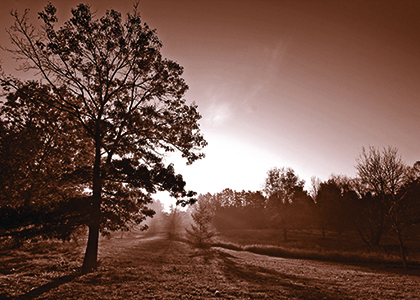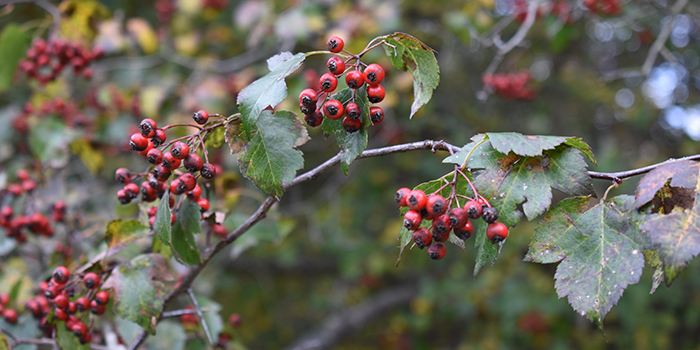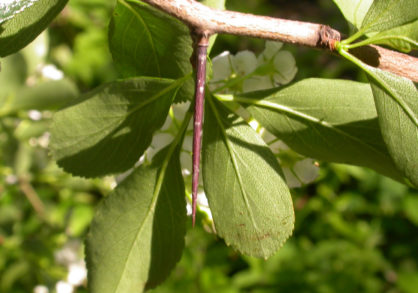
In the Northern Hemisphere, the long warm days of summer have ended, and the bounty of the growing season has been harvested. During this annual shift from growth and abundance toward darkness and dormancy, some cultures believe that the ephemeral side of life can return to the physical world. Plants have provided both connection with, as well as protection from, ethereal energies. Explore stories of three plants in our collections associated with the origins and traditions of Halloween, one of many cultural traditions that acknowledge this period of seasonal transition.
Today’s Halloween traditions trace its roots to the British Isles and Ireland where ancient Celtic and possibly pre-Celtic people celebrated a festival known as Samhain, pronounced sah-win or sow-in. Samhain begins at sunset on October 31st and continues until sunset on November 1.
During this cyclic shift into the darker phase of the year, Celtic people believed that beings who existed in the spirit world could briefly return to the physical world and walk among the living. Some of the spirits who roamed among the living were considered to be of the benevolent kind while others manifested malevolent energy. The custom of wearing costumes or disguises was intended to avoid being recognized by ghostly pranksters. Hollowed out turnips carved with scary facial features held candles or glowing embers meant to frighten away malicious spirits. Pumpkins were adapted for Halloween festivities by Irish immigrants who arrived in the U.S. in the 19th century during the Irish potato famine.
Certain plants believed to possess magical and protective qualities were employed to fend off unwelcome specters particularly during this potent time when the physical and the spirit worlds merge.
European Elder
European elder, Sambucus nigra, is indigenous to much of Europe and is widespread throughout the U.K. and Ireland. Elder is a large woody shrub that bears edible dark purple berries in late summer that can be made into juice, wine, syrup, jelly, sauces, and baked into pie. The flowers, fruit, leaves, and bark have a long history of use in traditional folk medicine. The common name elder comes from the old Anglo-Saxon word aeld, meaning fire, because the hollowed-out woody stems were blown into to help ignite kindling. American elderberry, Sambucus canadensis, is indigenous to North America and has similar uses.
Elder also has a long rich history as a plant imbued with protective powers. The shrubs were often planted near homes and the leaves tied to windows and doors as a means of discouraging witches and evil spirits from entering. Elder twigs twisted into crosses were placed on stables to protect livestock from evil spirits and spells. The green branches were placed in graves to protect the dead from evil entities.

Several varieties of elderberry can be found in the Zucker Shrub Collection, Mullestein Hillside Garden, and the Mundy Wildflower Garden.
European Wild Apple
Apples played a significant part in Celtic Samhain festivities. The European wild apple (Malus sylvestris), also known as the forest apple, is the only apple species native to the United Kingdom and Ireland and is widespread throughout Europe. Wild forest apple trees bear small, tart edible fruit that ripen in the fall and can be pressed into cider, cooked into sauce, and combined with cooked meats and poultry. Domesticated apple varieties, Malus domestica, contain wild apple genes.
During Samhain, apples were placed in cemeteries, on top of or buried in the soil of graves to provide food for the departed on their journey to the Spirit World. Bobbing for apples in a barrel of water, an old-fashioned Halloween party game, stemmed from ancient Samhain traditions along with foretelling a person’s life mate with an unbroken apple peel that hopefully revealed the initials of one’s future beloved. Halloween celebrations in the U.S. today often include apple cider, caramel apples, or glossy red candy apples and have roots in ancient Celtic traditions.
Visit our Flowering Tree Collection and Crabapple collection in the Newman Arboretum to view many varieties that are descendants of Malus sylvestris.
Hawthorn
Hawthorn (Crataegus sp.) has a long history as a sacred and enchanted tree among Celtic and pagan communities in the U.K. and Ireland where the trees are believed to be portals or gateways into the fairy realm. Traditionally associated with Beltane and Samhain festivals, their bright red berries auspiciously adorn the branches in October during the time of Samhain when the fabric between the physical world and the spiritual realm is most transparent.

Seven different species of hawthorn can be found in the arboretum, including a grove of hawthorns at the entrance of the Zucker Shrub Collection and within the Beech Collection. Several trees are also found in the Mullestein Winter Garden, which provide colorful fruit during colder months.
Plants in our collections
Click on the images below to learn more and where to find them.


